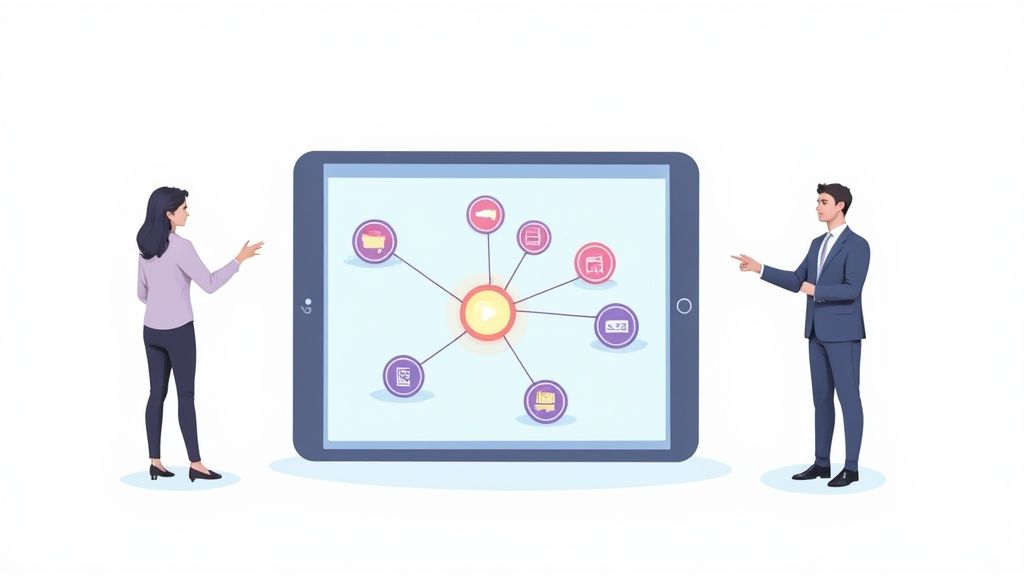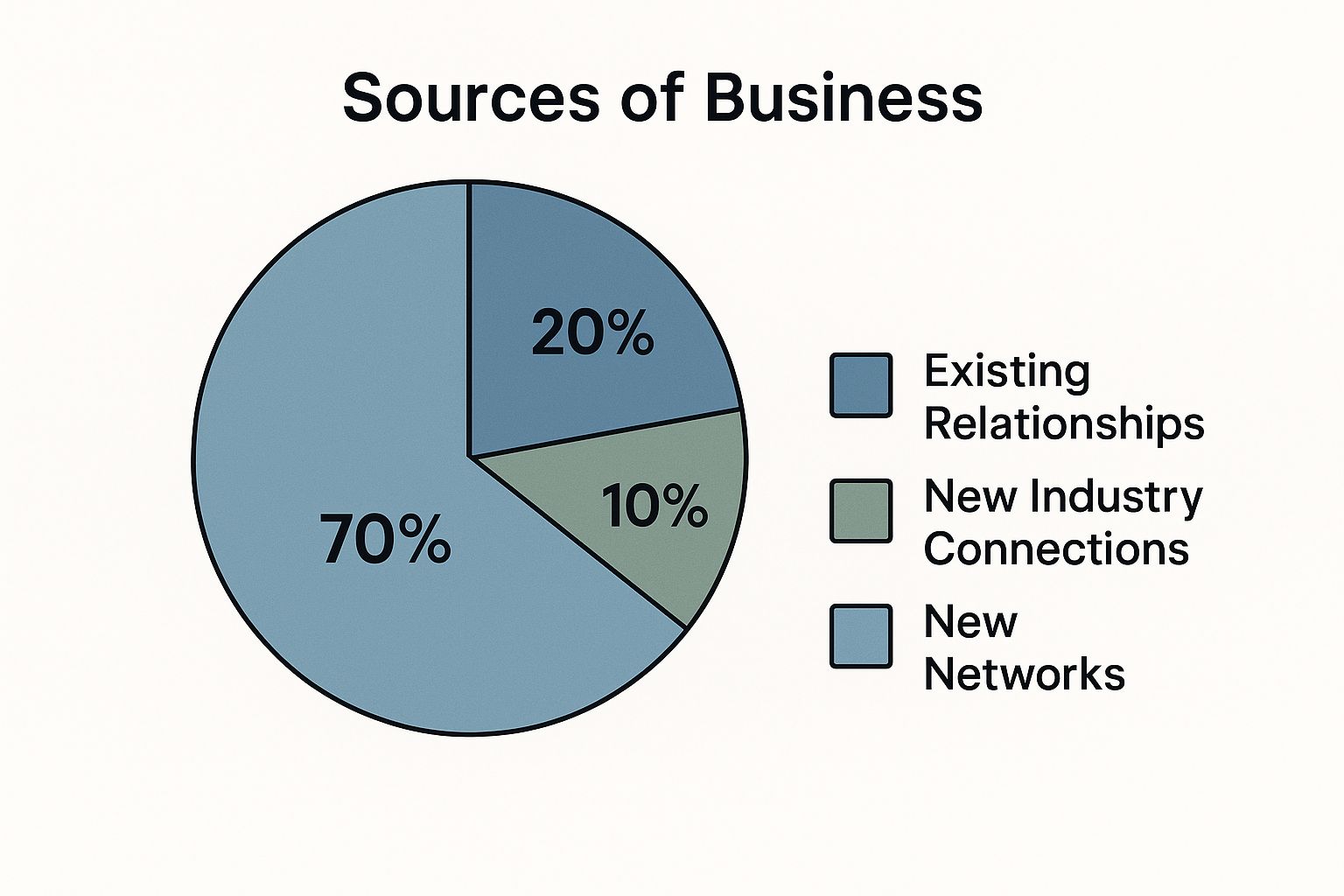
7 Advanced Networking Tips for Professionals in 2025
Published
In the fast-paced fields of influencer and digital marketing, the old advice of simply shaking hands and passing out business cards is obsolete. Genuine professional growth now stems from building authentic, strategic relationships, but navigating this landscape can feel overwhelming. Are you focusing on the right people? Are your follow-ups making an impact, or are they getting lost in the noise? The difference between a stagnant career and exponential growth often lies in the quality of your professional connections.
This guide moves beyond generic advice to provide a concrete framework for impactful relationship-building. We will explore 7 actionable networking tips for professionals designed to help you create a powerful, supportive, and career-advancing network. You will learn specific, implementable strategies that deliver measurable results, from optimizing your digital presence to maximizing in-person events. Whether you are a brand strategist seeking new collaborations, a social media specialist hunting for your next remote opportunity, or an agency leader expanding your influence, these techniques offer a clear roadmap. Prepare to connect with a level of purpose and precision that sets you apart in today's competitive environment.
1. The 70-20-10 Networking Rule
Effective networking isn’t just about collecting contacts; it’s about strategically building and maintaining a diverse portfolio of relationships. The 70-20-10 rule, a framework popularized by business leaders and career coaches, provides a balanced approach. It’s one of the most powerful networking tips for professionals because it shifts the focus from purely hunting for new connections to cultivating a sustainable, supportive network. This model advocates for allocating your networking time and energy across three distinct categories to ensure both stability and growth.
How to Allocate Your Networking Efforts
The rule suggests a clear division of your efforts:
- 70% on Nurturing Existing Relationships: The majority of your time should be dedicated to the people who already know, trust, and support you. This includes current and former colleagues, past clients, and long-standing industry peers. These relationships are your strongest asset, providing reliable advice, referrals, and opportunities.
- 20% on Developing New Industry Connections: This segment focuses on expanding your circle within your immediate professional world. For a digital marketing specialist, this means connecting with other marketers, content strategists, or SEO experts. These connections keep you informed about industry trends and open doors to new collaborations.
- 10% on Exploring New Networks: The final portion is for stepping outside your comfort zone. This involves connecting with professionals in completely different industries or fields. This exploratory effort can spark innovative ideas, reveal unexpected career paths, and protect you from industry-specific downturns.
This pie chart visualizes the strategic allocation of networking time according to the 70-20-10 rule.

As the chart illustrates, the framework heavily prioritizes maintaining and deepening existing connections, which form the bedrock of a strong professional network.
Putting It Into Practice
To implement this strategy, start by auditing your current networking activities. Use a simple spreadsheet or a CRM tool to categorize your contacts. Set monthly goals, such as scheduling two virtual coffees with existing contacts (70%), attending one industry-specific webinar (20%), and connecting with one professional from an adjacent field like fintech or ed-tech (10%). Regularly reviewing and adjusting these percentages based on your career goals, such as seeking a promotion versus exploring a new venture, ensures your networking remains purposeful and effective.
2. Strategic Follow-Up Within 48 Hours
The value of a new connection is often determined in the moments immediately following the initial interaction. Sending a strategic follow-up within 48 hours is a critical practice that transforms a fleeting conversation into a tangible relationship. This timely approach, advocated by networking experts like Keith Ferrazzi, capitalizes on the momentum of your first meeting. It demonstrates professionalism, genuine interest, and respect for the other person's time, making it one of the most impactful networking tips for professionals aiming to build a strong, memorable presence.

This prompt follow-up ensures the details of your conversation are still fresh, allowing for a more personal and relevant message that avoids generic platitudes. By acting quickly, you move from being just another business card to becoming a proactive and memorable contact.
How to Craft an Effective Follow-Up
A powerful follow-up goes beyond a simple "nice to meet you." It should be personalized, add value, and suggest a clear path forward.
- Reference a Specific Detail: Mention a specific topic you discussed, such as a shared interest in AI-driven analytics, a project they mentioned, or a particular challenge they are facing. This shows you were actively listening. For example, "I really enjoyed our chat about the future of TikTok creator collaborations at yesterday's summit."
- Provide Value: Your follow-up is an opportunity to be helpful. Share a relevant article, a link to a tool you mentioned, or an introduction to someone in your network who could be a useful contact for them.
- Include a Clear Call-to-Action: Don't leave the next step ambiguous. Suggest a brief virtual coffee, a quick call to continue the discussion, or simply state your intention to stay in touch. A well-crafted follow-up can even share similarities with a powerful application follow-up email in its clarity and purpose.
Putting It Into Practice
To make the 48-hour rule a seamless part of your networking workflow, preparation is key. During any networking event or meeting, discreetly jot down key points or names on a notepad or in your phone. After the event, dedicate a block of time to sending out your follow-ups. Use templates that can be quickly personalized to save time without sacrificing authenticity. A sales professional might send a LinkedIn request noting, "Great discussing your Q3 launch challenges. Here's that case study on audience segmentation I mentioned." This simple, timely action solidifies the connection and paves the way for a lasting professional relationship.
3. The Value-First Networking Approach
True networking is less about what you can get and more about what you can give. The value-first approach flips the traditional script, prioritizing providing value to others before asking for anything in return. This philosophy, championed by figures like Adam Grant in his book Give and Take, centers on building authentic relationships grounded in trust and generosity. It’s one of the most effective networking tips for professionals because it transforms you from a contact-seeker into a valuable, sought-after resource.

By consistently offering help, sharing knowledge, and making connections for others without expecting immediate reciprocation, you establish a strong reputation. This goodwill naturally leads to more meaningful and fruitful professional opportunities down the line.
How to Offer Value Authentically
Adopting a value-first mindset means actively looking for ways to support your network. The goal is to become a "giver" rather than a "taker."
- Share Knowledge and Resources: If you read an insightful article about a new influencer marketing trend, share it with a contact who could benefit. For example, a brand strategist could send a report on emerging Gen Z platforms to a colleague managing a youth-focused campaign.
- Make Strategic Introductions: Connect two people in your network who could mutually benefit, even if there's no direct gain for you. A digital marketer might introduce a talented graphic designer to a startup founder who needs branding help.
- Provide Specific, Actionable Help: Listen actively to your contacts' challenges. If a fellow social media specialist mentions struggling with analytics, you could share a template for a reporting dashboard you use or offer a quick 15-minute call to walk them through a helpful tool.
- Offer Praise and Recognition: Publicly acknowledge a colleague's success on LinkedIn or endorse their skills. This simple act builds goodwill and strengthens professional bonds.
Putting It Into Practice
To implement this approach, start by being more intentional in your interactions. Before reaching out to someone, ask yourself, "How can I help this person or add value to their work?" Keep a simple log of your key contacts' professional goals and challenges.
Set a goal to perform one "value-add" action each day, whether it’s sharing a relevant post, making an introduction, or offering a piece of advice. This consistent, selfless effort compounds over time, building a robust and loyal network that is genuinely invested in your success because you have consistently invested in theirs.
4. The Coffee Chat Strategy
The coffee chat is a classic, low-pressure networking approach that strips away the formality of boardrooms and structured meetings. It involves inviting a contact for an informal conversation over coffee (or tea, or a virtual call) to build a genuine relationship. This strategy, a staple in Silicon Valley and career coaching circles, is one of the most effective networking tips for professionals because it fosters authentic connection and allows for deeper, more personal conversations than a typical business setting permits. It’s about exploring mutual interests and opportunities in a relaxed environment, making it feel less like a transaction and more like a conversation between peers.

This casual format is perfect for building rapport, whether you're a job seeker learning about company culture, a freelancer exploring collaborations, or an entrepreneur seeking advice from a seasoned mentor.
How to Allocate Your Networking Efforts
The key to a successful coffee chat is preparation and intentionality, balanced with a natural, conversational flow. It's not an interview; it's a mutual exchange.
- Relationship Building (60%): The primary focus should be on getting to know the other person. Ask about their career journey, their current projects, and their passions outside of work. The goal is to find common ground and establish a genuine connection that can serve as the foundation for a professional relationship.
- Information Gathering (30%): This is your chance to gain valuable insights. A digital marketing specialist might ask a senior leader about emerging industry trends, or a job seeker might inquire about a company's approach to work-life balance. Prepare a few thoughtful questions to guide the conversation.
- The "Ask" (10%): A subtle and respectful "ask" can be appropriate, but it should be a small part of the conversation. This could be a request for an introduction to someone else in their network, advice on a specific challenge, or simply asking if you can keep in touch. This part should feel like a natural next step, not the sole purpose of the meeting.
The strategy's power lies in its personal touch, making it a memorable and impactful way to expand and deepen your professional circle.
Putting It Into Practice
To implement the coffee chat strategy, start by identifying individuals you admire or wish to learn from. Send a concise, personalized invitation via LinkedIn or email, clearly stating your purpose. For example, "I've been following your work in influencer marketing at [Company] and would love to treat you to a coffee to learn more about your experience." During the meeting, be an active listener. As the initiator, always offer to pay. Afterward, send a thank-you note within 24 hours, referencing a specific point from your conversation to reinforce the connection and show you were engaged.
5. Digital-First Networking with LinkedIn Optimization
In today’s digitally driven world, your online presence often precedes any in-person introduction. A digital-first networking approach leverages platforms like LinkedIn not just as a resume repository, but as a dynamic hub for relationship building. This strategy is one of the most crucial networking tips for professionals because it allows you to connect with, influence, and nurture professional relationships at scale, regardless of geographical barriers. It focuses on optimizing your online profile, engaging with relevant content, and strategically using platform features to build a powerful and active network.
How to Allocate Your Networking Efforts
This digital-first model reorients traditional networking toward online platforms:
- Optimize Your Profile for Impact: Your LinkedIn profile is your digital storefront. It needs a professional headshot, a compelling headline that goes beyond your job title, and a summary that tells your professional story. Think of it as your personal branding foundation, essential for making a strong first impression. For those focusing on digital outreach, optimizing your LinkedIn presence is paramount. Explore more LinkedIn networking tips to enhance your online professional profile and outreach.
- Engage with Purpose: Passive scrolling won't build connections. Actively engage with content in your feed by leaving thoughtful comments on posts from industry leaders and peers. This increases your visibility and positions you as an engaged member of your professional community. Sharing valuable content, whether it's your own insights or relevant articles, establishes you as a thought leader.
- Connect Strategically: Use LinkedIn’s advanced search features to find and connect with relevant professionals in your target industries or companies. When sending a connection request, always include a personalized message explaining why you want to connect. This small step significantly increases your acceptance rate and starts the relationship on a positive note.
Putting It Into Practice
To effectively implement this strategy, make LinkedIn a part of your daily or weekly routine. Start by dedicating 15 minutes each day to engaging with your feed. For instance, a marketing professional can build thought leadership by posting weekly insights on a recent campaign and commenting on five industry-related posts daily. A consultant might use LinkedIn Sales Navigator to identify and build a list of potential clients, then engage with their content for a week before sending a personalized connection request. This consistent, strategic activity transforms your profile from a static page into a powerful networking engine and is a key part of building a strong personal brand.
6. Industry Event Maximization Strategy
Attending industry conferences and seminars without a clear plan often results in missed opportunities and a stack of forgotten business cards. The Industry Event Maximization Strategy transforms these gatherings from passive learning experiences into active relationship-building platforms. This systematic approach is one of the most critical networking tips for professionals because it ensures you derive measurable value from your time and investment. It involves a three-phase process: pre-event preparation, strategic on-site engagement, and diligent post-event follow-up.
How to Systematize Your Event Networking
A successful event strategy begins long before you arrive and continues long after you leave. The goal is to move beyond chance encounters and create purposeful connections.
- Pre-Event Preparation: This is the most crucial phase. Research the event's speakers, sponsors, and, if possible, the attendee list. Identify key individuals you want to meet, such as potential clients, collaborators, or mentors. Reach out beforehand to schedule brief 15-minute coffee meetings.
- Strategic On-Site Engagement: During the event, prioritize your scheduled meetings. For spontaneous networking, prepare a flexible elevator pitch tailored to different audiences (e.g., a potential investor versus a peer). Focus on quality conversations over quantity, and attend social mixers or receptions where interactions are more informal.
- Systematic Post-Event Follow-Up: Within 48 hours, send personalized follow-up emails to everyone you met. Reference a specific detail from your conversation to make it memorable. Connect on LinkedIn with a custom message and schedule follow-up calls to discuss concrete next steps.
Maximizing your impact at industry events is a cornerstone of professional networking. For more detailed strategies on navigating conferences effectively, consider these advanced conference networking tips.
As demonstrated, a proactive and organized approach can dramatically increase your networking ROI at any professional gathering.
Putting It Into Practice
To implement this, create an "Event Action Plan" for each conference you attend. Use a spreadsheet to list your top 10 target contacts with their company and role. Track your outreach efforts before the event, noting who has agreed to meet. During the event, take concise notes on the back of each business card you receive. Afterward, use your spreadsheet to manage your follow-up cadence, ensuring no valuable connection falls through the cracks. This structured method turns a chaotic event into a predictable pipeline for building powerful professional relationships.
7. Mutual Connection Leveraging
Cold outreach is often a low-yield, high-effort game. Mutual connection leveraging transforms this dynamic by turning a cold approach into a warm introduction, significantly increasing your chances of success. This strategy is about tapping into the trust and credibility of your existing network to build bridges to new, valuable contacts. It’s one of the most effective networking tips for professionals because it relies on the power of a trusted endorsement, making new connections feel more natural and less transactional. By using a shared relationship as the foundation, you immediately establish a baseline of trust.
How to Leverage Mutual Connections
The core principle is to ask a person you both know to facilitate an introduction. This "social proof" from a mutual contact makes the recipient far more likely to respond positively.
- Warm Introductions: Instead of a cold email, a warm introduction comes from a trusted source. For example, a startup founder asking an early-stage investor to introduce them to other VCs in their network.
- Targeted requests: The goal isn't to ask for broad access to someone's entire contact list. It’s about making specific, well-reasoned requests. A social media strategist might ask a former colleague for an introduction to the Head of Content at a target company they admire.
- Credibility Transfer: The trust the recipient has in your mutual connection is partially transferred to you, giving you an immediate advantage and a solid starting point for a new professional relationship.
This approach is particularly powerful in close-knit industries like influencer marketing, where reputation and trusted referrals are paramount. It bypasses the gatekeepers and noise that often accompany cold outreach.
Putting It Into Practice
To implement this strategy effectively, preparation and etiquette are key. First, use platforms like LinkedIn to identify shared connections with individuals you want to meet. When you find a promising link, don't just send a generic "Can you introduce me?" message.
Instead, make the process as easy as possible for your contact. Draft a short, forwardable blurb they can send on your behalf. This message should concisely explain who you are, why you want to connect with the specific person, and what value you might offer. Always be explicit about your intentions, whether it's for advice, a potential collaboration, or exploring a job opportunity. Finally, remember to thank your contact for making the introduction and keep them updated on the outcome. This simple follow-up shows respect for their time and reputation, making them more willing to help you again in the future. For more on this, you can explore strategies on how to build strong client relationships on influencermarketingjobs.net, as the principles are highly transferable.
Networking Strategies Comparison Matrix
| Networking Strategy | Implementation Complexity 🔄 | Resource Requirements ⚡ | Expected Outcomes 📊 | Ideal Use Cases 💡 | Key Advantages ⭐ |
|---|---|---|---|---|---|
| The 70-20-10 Networking Rule | Medium - requires tracking and balance | Moderate - time allocation tracking | Balanced network growth and stability | Professionals seeking structured networking mix | Maximizes ROI on networking time |
| Strategic Follow-Up Within 48 Hours | Low - requires prompt action | Low - timely communication tools | Higher response and engagement rates | New connections needing quick rapport building | Builds professionalism and reliability |
| Value-First Networking Approach | Medium - ongoing giving focus | High - significant time and effort | Strong trust-based, long-term relationships | Those investing in reputation and goodwill | Creates deep, sustainable connections |
| The Coffee Chat Strategy | Medium - requires scheduling and effort | Moderate - time and location setup | Authentic, personal relationship building | Low-pressure, informal networking scenarios | Facilitates genuine conversation and trust |
| Digital-First Networking with LinkedIn Optimization | Medium - profile and content management | Moderate - digital tools and time | Wide reach with scalable relationship growth | Professionals leveraging online networking | Global accessibility with measurable impact |
| Industry Event Maximization Strategy | High - event prep, travel, follow-up | High - time, money, and logistics | Intensive, targeted networking outcomes | Event attendees aiming for concentrated outreach | Access to many relevant contacts in one place |
| Mutual Connection Leveraging | Low - depends on existing network | Low - mostly communication effort | Warm introductions and higher success rates | Professionals with solid network looking to expand | Leverages trust for easier introductions |
From Connections to Career Growth
Mastering the art of professional networking is less about collecting contacts and more about cultivating a dynamic, supportive ecosystem that fuels your career. The strategies we've explored move beyond outdated, transactional tactics, offering a modern framework for building meaningful, lasting relationships in the digital and influencer marketing landscape. By implementing these advanced networking tips for professionals, you transform a passive list of names into an active asset for growth, innovation, and opportunity.
The journey begins with a structured, intentional approach. Adopting the 70-20-10 Rule ensures your efforts are balanced and sustainable, preventing burnout while maximizing impact. It’s not just about attending events; it’s about strategically allocating your time to nurture existing ties, expand your immediate circle, and explore aspirational connections that push you forward. This structured method, combined with the discipline of a Strategic Follow-Up Within 48 Hours, cements your first impression and turns a fleeting conversation into a tangible next step.
Turning Theory into Action
True networking prowess lies in demonstrating value before you ask for it. The Value-First Approach fundamentally shifts the dynamic from "What can you do for me?" to "How can I help you?" This philosophy is the cornerstone of every successful interaction, whether you're optimizing your LinkedIn profile to serve as a resource or maximizing your time at industry events by focusing on mutual interests rather than just your own agenda. This mindset builds trust and positions you as a genuine, collaborative professional whom others actively want in their circle.
To truly maximize your efforts and translate connections into tangible career advancements, explore additional comprehensive resources on tips for successful business networking which can provide further depth and tactical guidance. The key is to see every interaction as a seed. Whether it's a casual coffee chat or a formal introduction through a mutual connection, each touchpoint has the potential to grow into a fruitful professional relationship.
The Ultimate Goal: A Network That Works for You
Ultimately, the goal is to build a network that is not just large, but alive and responsive. It should be a source of industry insights, a sounding board for new ideas, and a powerful engine for career opportunities. The networking tips for professionals outlined in this guide are your blueprint. They empower you to move with confidence, build authentic rapport, and strategically position yourself as an indispensable player in your field. Remember, the most powerful connections are built on a foundation of consistency, authenticity, and a genuine desire to contribute to the success of others. Start today, be persistent, and watch as your professional world expands in ways you never thought possible.
Ready to put your newly honed networking skills to the test and connect with top brands and agencies? Explore the latest opportunities on Influencer Marketing Jobs and find your next role in the dynamic world of influencer and digital marketing. Sign up for our weekly job alerts to have curated openings delivered directly to your inbox.